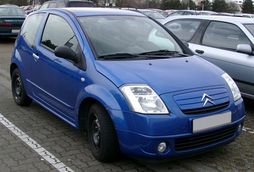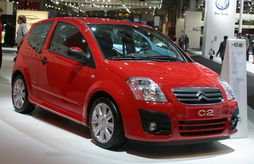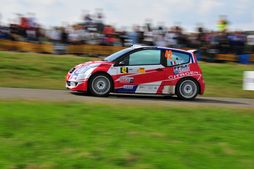The History Of Citroen C2

The Citroën C2 is a supermini produced by the French manufacturer Citroën since 2003. A completely different car, based on the Peugeot 206, is sold in China as the C2.
Along with the Citroën C3, the C2 was intended to replace the popular Citroën Saxo. The two cars have relatively different designs allowing Citroën to grab different sub-markets of the supermini class. The C2 was designed by Donato Coco. The C3 was originally designed as a larger "family friendly" vehicle" being 5 doors, whereas the C2 is seen as a "young driver" image with 2 doors and flatter styling, though still with low power.
The L model is the "no-frills" version of the C2 and comes with basic equipment, including black plastic bumpers and no fog lamps. The LX model, produced from 2003 to 2005, came with black lower bumper and door handles, CD player, rear seat modulation and no fog lamps. The Design includes body-coloured bumpers and electric windows. The SX is the luxury spec. It features 'bumper colour coded paint' and air conditioning, the latter of which has an unfortunate effect on the 1.1 SX performance, increasing the 0-100 km/ h time by 3 seconds to 17.2 seconds.
The Furio, VTR and VTS are the sports models which made the C2's predecessor, the Saxo, famous as an affordable, sporty-looking and very fast 'pocket rocket'. The Furio has exactly the same sports body kit as the more expensive VTR and VTS models but lacks the alloy wheels of those models.
The VTR also has an adequate 110bhp (82kW; 112PS) engine, whereas the VTS is the premium sports model, with a 125bhp (93kW; 127PS) engine capable of accelerating from 0 to 60mph (97km/ h) in 8.2 seconds, seen as sluggish by modern hot hatch standards where the fastest hot hatch achieves 5.3 seconds (Clio V6), although this is obviously designed to be more insurance-friendly. Other additions which helped the VTS model achieve a low insurance rating (in the UK) were security based including deadlocks and a Thatcham Category 1 alarm system which includes perimeter and volumetric detection as well as engine immobiliser.
2004's limited edition GT model offered a sporty bodykit, with bright red, blue, silver and black paintwork and unique white alloy wheels. All GTs had a number certificate to show their authenticity.
2006 saw a number of small revisions to the C2. Externally the car looks identical save minor changes to alloy wheels (on the VTR), half colour coded door mirrors, clear side indicator lenses, and white indicator rear lenses. Internal changes saw a new electrical system, new stereo with vehicle computer integration and some cosmetic changes to the driver displays and centre console.
The VTR Sensodrive and VTS Manual are the two current petrol options available for the Australian C2.
Technology
The Citroën C2 brings with it two key new technologies, the Stop & Start environmental system, and the SensoDrive five speed semi-automatic transmission.
- The Stop & Start is a hybrid system, with the internal combustion engine being supplemented by a small electric motor. The "Stop & Start" system automatically disengages the engine when you bring the vehicle to a complete stop, with pressure being applied to the brake pedal. The engine quickly restarts when pressure on the brake pedal is relieved. The technology has been developed by Valeo and results in lower urban fuel consumption. The system, however, requires pressure on the brake pedal when stationary for the system to work - holding the vehicle on the handbrake (parking brake) alone will not be sufficient for the system to operate. The Stop & Start system is mounted to the SensoDrive gearbox.
Similar technology to the Stop & Start system was previously seen in the 1980s, with the VW Polo "Formel E" and the VW Golf MKIII "Ecomatic".
- The SensoDrive five speed semi-automatic transmission is an electronically controlled manual gearbox, with the clutch and gear-change functions electronically managed. As a result, the vehicle has no clutch pedal and the gear lever - which remains present - has no mechanical link with the gearbox. The SensoDrive gearbox is managed by a control unit, which controls two actuators. One actuator changes gears while the other, which is equipped with a facing wear compensation system, opens and closes the clutch. The gearbox control unit also dialogues with the engine control unit. The SensoDrive gearbox has two shifting options of either the fully automated mode, or the paddle-shifted/ gear-shifted manual mode.
Engines available
- 1.1 L TU1 (1124 cc) I4, 60 PS (59 hp/ 44 kW)
- 1.4 L TU3 (1360 cc) I4, 75 PS (73 hp/ 55 kW)
- 1.4 L ET3 SensoDrive Stop & Start (1360 cc) I4, 90 PS (88 hp/ 66 kW)
- 1.4 L DV4 HDi Diesel (1398 cc) I4, 68 PS (67 hp/ 50 kW) and 111 ft·lbf (150 N·m)
- 1.6 L TU5 SensoDrive VTR (1587 cc) I4, 110 PS (108 hp/ 80 kW)
- 1.6 L TU5 VTS (1587cc) I4, 125 PS (123 hp/ 91 kW)
UK trim levels 2003 - 2008
- L
- Airplay
- LX
- Design
- Cool
- SX
- Stop & Start
- Furio
- VTR
- VTS
- GT (Limited Edition 2004)
- Loeb (Limited Edition 2007)
- Code (Limited Edition 2007)
UK trim levels 2008 onwards
- Vibe 1.1i and 1.4HDi.
- Rhythm 1.1i, 1.4i and 1.4HDi.
- Cachet 1.1i and 1.4i.
- Stop & Start 1.4i 16v 90bhp (67kW; 91PS) Sensodrive.
- VTR 1.4i, 1.6i 16v 110bhp (82kW; 112PS) Sensodrive and 1.4HDi.
- VTS 1.6i 16v 125bhp (93kW; 127PS) and 1.6HDi 16v 110bhp (82kW; 112PS).
- Code 1.6i 16v 125bhp (93kW; 127PS).
April 2008 saw Citroen Europe announcing a facelift for its C2 model. The car, launched in 2003, received a minor update in 2006. The C2 now features a larger front bumper, and restyled grille including a chrome surround. The trim specifications remain in-line with the 2008 range.
Starting in October 2006, the Peugeot 206 will be sold by PSA, for the Chinese market only, under the Citroën brand, with a modified front and rear body; this is similar to the way the Citroën LN was derived from the 104. The car will be sold as the Citroën C2, although it has no common features with the model sold on other markets, due to the positioning of the model in the Citroën China line-up.
According to forecasts, more than 40,000 units of this new vehicle will be produced in China at the Wuhan DPCA site over a full year.
After the success of Citroën's Xsara in the World Rally Championship (WRC), Citroën expanded their interests to achieve success not only in the WRC but in the support championship, the Junior World Rally Championship (JWRC) in 2004. The earlier Citroën Saxo Super 1600 JWRC car was highly successful. The car won the JWRC title with Sébastien Loeb in 2001, and brought him to the attention of Citroën Total World Rally Team, and again with Daniel Solà in 2002.
With the new C2 replacing the aging Saxo, Citroën concentrated upon making their new car a winner. Using a heavily modified C2 to create the Citroën C2 S1600, the works team and Dani Sordo succeeded in winning the championship in 2005. The C2 S1600 has continued to compete in the championship with privateer teams, and remains successful despite newer machinery from Suzuki, Renault and Fiat works teams. In the 2008 season, Sébastien Ogier brought the Citroën C2 its second junior title.
From Wikipedia, the free encyclopedia
More About Citroen C2



|